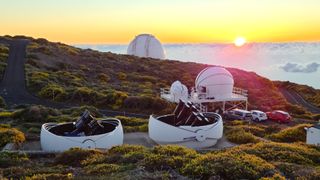The first telescope of its kind will hunt for sources of gravitational waves
A new telescope will hunt for sources of gravitational waves.

A brand new telescope will be the first to hunt for colliding black holes and neutron stars in a bid to find sources of gravitational waves.
Gravitational waves, the ripples in spacetime caused by the most energetic collisions known to the universe, were first detected in 2015 by the Laser Interferometer Gravitational-Wave Observatory (LIGO). So far, tracking the sources of these waves has been difficult.
Scientists liken the gravitational wave detections to sensing the vibrations of a road's surface when a truck has passed, but not being able to actually see the truck. It's almost impossible to know where to look with optical telescopes to search for the sources of these vibrations in the vast universe. The new telescope, called the Gravitational-wave Optical Transient Observer (GOTO), aims to change that.
"There are fleets of telescopes all over the world available to look towards the skies when gravitational waves are detected in order to find out more about the source," Professor Danny Steeghs, a head of the astronomy department at the University of Warwick in the U.K. and GOTO’s Principle Investigator, said in a statement. "But as the gravitational wave detectors are not able to pinpoint where the ripples come from, these telescopes do not know where to look."
Related: How a future gravitational wave detector in space will reveal more about the universe
Working closely with LIGO and other gravitational wave observatories such as the European Gravitational Wave Observatory, GOTO will scan the whole sky from locations in the Northern and Southern Hemisphere every few days.
Using sophisticated algorithms, the telescope's computer will analyze the images to look for sudden and intense brightenings in certain parts of the electromagnetic spectrum. Such brightenings might be triggered by collisions of the most massive objects in the universe, black holes and neutron stars. Neutron stars are remnants of supernova explosions, in which giant stars die. The explosions leave behind extremely dense remnants that may be only a few miles wide but pack more mass than the entire sun.
Get the Space.com Newsletter
Breaking space news, the latest updates on rocket launches, skywatching events and more!
While extremely energetic, the explosions produced by the collisions of these cosmic behemoths are also extremely fleeting, which makes the searching process in the aftermath of the gravitational wave detection challenging.
By pairing the gravitational ripple detection with promptly processed images from GOTO, astronomers would know where to point other, more powerful telescopes to study the cataclysmic events in greater detail.
"[GOTO] was always envisaged to be ... arrays of wide-field optical telescopes in at least two sites so that these could patrol and search the optical sky regularly and rapidly," Steeghs said.
"This will allow GOTO to provide that much-needed link, to give the targets for bigger telescopes to point towards."
GOTO was developed by a team of researchers at Australian and British universities. The first array, located at an observatory in La Palma in the Canary Islands off the coast of northern Africa, has recently been tested. The robotic observatory consists of 16 separate 16-inch (40 centimeter) telescopes clustered in two arrays, which between them share 800 million pixels of resolution, the researchers said in the statement. An identical array will soon be deployed at Australia's Siding Spring Observatory near Sydney.
The telescope should be ready for LIGO's next observing run, which is set to commence next year. Since the early gravitational wave detections in 2015, LIGO engineers have improved the instrument's sensitivity and it is now expected to detect gravitational waves from neutron star mergers as distant as 522 million to 620 million light-years from Earth. Larger and more violent events, such as the collisions and mergers of black holes, should be visible to LIGO at even greater distances.
If astronomers can locate the sources of these gravitational wave signals, they could characterize the sources, measure their distances and study their evolution, the researchers said.
"The hope is to catch the event quickly, then follow it as it fades, and also to trigger an alert to other, bigger telescopes so they can all collect more information and we can build a really detailed picture of these astronomical phenomena," Steeghs said. "It is a really dynamic and exciting time. In astronomy we are used to studying events which are millions of years old and aren’t going anywhere – this is a fast-paced, very different way of working where every minute counts."
Follow Tereza Pultarova on Twitter @TerezaPultarova. Follow us on Twitter @Spacedotcom and on Facebook.
Join our Space Forums to keep talking space on the latest missions, night sky and more! And if you have a news tip, correction or comment, let us know at: community@space.com.

Tereza is a London-based science and technology journalist, aspiring fiction writer and amateur gymnast. Originally from Prague, the Czech Republic, she spent the first seven years of her career working as a reporter, script-writer and presenter for various TV programmes of the Czech Public Service Television. She later took a career break to pursue further education and added a Master's in Science from the International Space University, France, to her Bachelor's in Journalism and Master's in Cultural Anthropology from Prague's Charles University. She worked as a reporter at the Engineering and Technology magazine, freelanced for a range of publications including Live Science, Space.com, Professional Engineering, Via Satellite and Space News and served as a maternity cover science editor at the European Space Agency.
